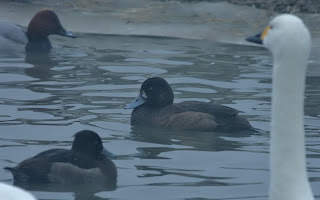This blog is now hosted by Squarespace. No more updates will be posted here.
Please now use either of the following URLs:
http://www.bluebirding.co.uk
http://bluebirding.squarespace.com
22 January 2011
18 January 2011
Miracle in the Marshes of Iraq.
Broadcast on BBC TWO this evening, Miracle in the Marshes of Iraq was a wonderful example of wildlife documentary making.
The program presented the work of Azzam Alwash, a man who grew up with the Mesopotamian Marshes in his soul, and a man blessed with the vision to restore the vast area - once dominant in south east Iraq - to its former glory. In the 1990's Saddam Hussein decided that in order to eradicate the indigenous people of the wetlands he would drain the region - turning it into a naked dustbowl. The rivers that once supplied the wetlands with water, like the Euphrates, were placed in straight-jackets and a network of canals was built to channel water towards the Gulf instead of the central marshes.
Today, Alwash is overseeing the return to life of the area. Birds, mammals, fish... the people. Here it all seemed as one. A way of life restored for everything.
Before this evening I had absolutely no idea the Mesopotamian Marshes ever existed, and no idea about the work that is taking place to restore them. Now I am captivated and will be donating to Nature Iraq, the organization Alwash established to give the work its core structure.
The return of birds shown in the documentary, from the characterful Pied Kingfisher, to the elegant Black-winged Stilt, to the Greater Flamingos, Iraq Babbler and mostly heartening of all... the Basra Reed Warbler (almost endemic to the region) demonstrate that if you provide the environment they will come. The most amazing sight, however, was a flock of c.40,000 Marbled Teal, a species last seen in the country over 20 years ago. The look on the film maker's, and Alwash's face, was unforgettable. He could see the past erupting into life and could not contain his delight.
Of course, the film was careful to highlight what a dangerous place Iraq remains, and we were never far away from a weapon, or bunker, or armoured vehicle. This stuff demands attention, too. If only the country could stabilise sufficiently that tourism could gain even a slender foothold, I've no doubts these wetlands would represent an essential 'eco-tourism' destination. Sure, even from a environmental point of view the comeback is a slow one ("two steps forward, once step back... but on the right track", as Alwash put it). For example there are issues with maintaining sufficient water supply to allow full restoration of the marshes. Dams upstream in Syria and Turkey rob the region of the water supply it once enjoyed, and so Alwash has had to get creative with the water trapped in Saddam's canal network. But still... the place looked, frankly, awesome.
A glowing word, also, for the film makers themselves. There was a well thought out narrative to the program, no talking down to the audience, and the problems were laid out as openly as the successes.
Here is a link the program in the BBC's iPlayer - http://www.bbc.co.uk/iplayer/episode/b00xxf9f/hd/Natural_World_20102011_Miracle_in_the_Marshes_of_Iraq/
If you need to put a spring in your step this winter, look no further.
Birding in Iraq.
What a prospect.
The program presented the work of Azzam Alwash, a man who grew up with the Mesopotamian Marshes in his soul, and a man blessed with the vision to restore the vast area - once dominant in south east Iraq - to its former glory. In the 1990's Saddam Hussein decided that in order to eradicate the indigenous people of the wetlands he would drain the region - turning it into a naked dustbowl. The rivers that once supplied the wetlands with water, like the Euphrates, were placed in straight-jackets and a network of canals was built to channel water towards the Gulf instead of the central marshes.
Today, Alwash is overseeing the return to life of the area. Birds, mammals, fish... the people. Here it all seemed as one. A way of life restored for everything.
Before this evening I had absolutely no idea the Mesopotamian Marshes ever existed, and no idea about the work that is taking place to restore them. Now I am captivated and will be donating to Nature Iraq, the organization Alwash established to give the work its core structure.
The return of birds shown in the documentary, from the characterful Pied Kingfisher, to the elegant Black-winged Stilt, to the Greater Flamingos, Iraq Babbler and mostly heartening of all... the Basra Reed Warbler (almost endemic to the region) demonstrate that if you provide the environment they will come. The most amazing sight, however, was a flock of c.40,000 Marbled Teal, a species last seen in the country over 20 years ago. The look on the film maker's, and Alwash's face, was unforgettable. He could see the past erupting into life and could not contain his delight.
Of course, the film was careful to highlight what a dangerous place Iraq remains, and we were never far away from a weapon, or bunker, or armoured vehicle. This stuff demands attention, too. If only the country could stabilise sufficiently that tourism could gain even a slender foothold, I've no doubts these wetlands would represent an essential 'eco-tourism' destination. Sure, even from a environmental point of view the comeback is a slow one ("two steps forward, once step back... but on the right track", as Alwash put it). For example there are issues with maintaining sufficient water supply to allow full restoration of the marshes. Dams upstream in Syria and Turkey rob the region of the water supply it once enjoyed, and so Alwash has had to get creative with the water trapped in Saddam's canal network. But still... the place looked, frankly, awesome.
A glowing word, also, for the film makers themselves. There was a well thought out narrative to the program, no talking down to the audience, and the problems were laid out as openly as the successes.
Here is a link the program in the BBC's iPlayer - http://www.bbc.co.uk/iplayer/episode/b00xxf9f/hd/Natural_World_20102011_Miracle_in_the_Marshes_of_Iraq/
If you need to put a spring in your step this winter, look no further.
Birding in Iraq.
What a prospect.
16 January 2011
Hugely Exciting Garden Birds.
15 January 2011
Goldeneye.
09 January 2011
Sharpness.
In glorious sunshine, a poke around the habitats at Sharpness at high tide (1030hrs to approximately 1300hrs). Maybe something good would come up river, or on the turn?
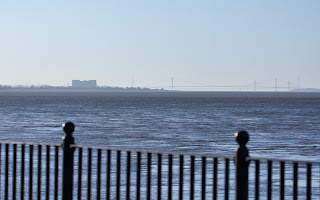
No. Maybe a Black Redstart would show up?
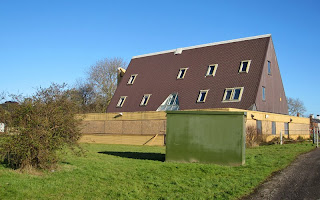
No. But there were plenty of...
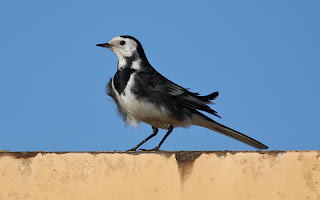
Still, the Pied Wags plus six others for the year list (now 74) in the form of (and in chronological order*) Pied Wagtail (lol), Wren (lol), Reed Bunting, Grey Wagtail, Goldfinch, Rock Pipit (the 'double picture' below is of the same bird) and Redshank. Nothing remarkable, but in this weather you really can't avoid a good view of a bird. Six Cormorants were observed flying down river, and many Gulls (mostly Common) were seen to float down on the tide along with two Shelduck. The Redshanks (two birds) showed well just as the mud began to expose, as did two Curlews. Finally, a flock of c.10 Linnets were seen a number of times. Too wary to pin down for a photograph.
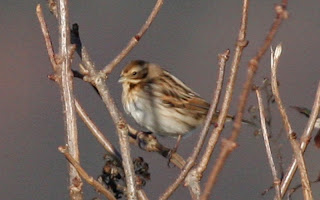
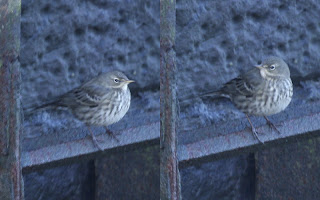
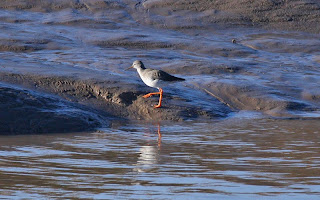
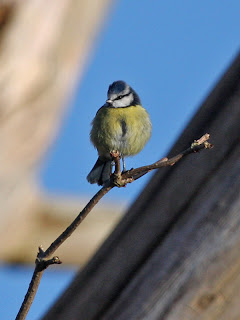
I love the scrub area just beyond the Ned West building. It's a great spot to watch the various Tits and Finches going about their business.
Between Berkeley and Sharpness I stopped to watch a couple of Kestrels (1m/1f) engaged in battle / courtship. They were alternately ambushing each other over the right to sit atop this electricity pylon.
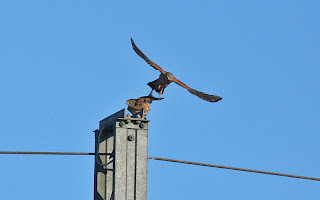
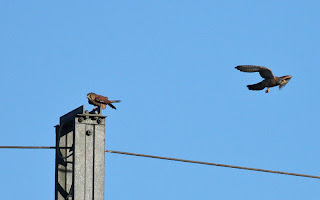
*I always keep my year list in the precise order I see each new bird, which makes a notebook essential. One can easily forget the order after the fact.

No. Maybe a Black Redstart would show up?

No. But there were plenty of...

Still, the Pied Wags plus six others for the year list (now 74) in the form of (and in chronological order*) Pied Wagtail (lol), Wren (lol), Reed Bunting, Grey Wagtail, Goldfinch, Rock Pipit (the 'double picture' below is of the same bird) and Redshank. Nothing remarkable, but in this weather you really can't avoid a good view of a bird. Six Cormorants were observed flying down river, and many Gulls (mostly Common) were seen to float down on the tide along with two Shelduck. The Redshanks (two birds) showed well just as the mud began to expose, as did two Curlews. Finally, a flock of c.10 Linnets were seen a number of times. Too wary to pin down for a photograph.




I love the scrub area just beyond the Ned West building. It's a great spot to watch the various Tits and Finches going about their business.
Between Berkeley and Sharpness I stopped to watch a couple of Kestrels (1m/1f) engaged in battle / courtship. They were alternately ambushing each other over the right to sit atop this electricity pylon.


*I always keep my year list in the precise order I see each new bird, which makes a notebook essential. One can easily forget the order after the fact.
08 January 2011
Water Park West.
Always good for a few hours birding, I took advantage of a necessary visit to the Outdoor Store to drop in on a few of the key pits before the football started in the afternoon. I hadn't birded there since last Spring, so I was concerned I'd spend more time trying to remember the various good access points to the pits than actually birding. As it turned out, it was like riding a bike... you never forget!
Of course, every pit had varying numbers of Gadwall, Tufted Duck, Pochard and all but pit 12 contained Wigeon. Without any given purpose, I won't count Gulls (scan through them, of course)... so let's just say there were lots of each pretty much everywhere except GBBGs, or which I saw very few.
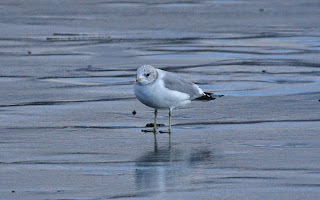
Pit 12 brought me my first Common Gull of the year (photo above of the first one I clapped eyes on) alongside my first Little Grebe, Great Crested Grebes and Goldeneye (3m/1f) of the year. There were perhaps 20 Mute Swans present, frequently taking flight and - every time - amusing as they attempted touchdown on the ice. Plenty of Black-headed Gulls but no candidates for Med.
Pit 17. A Great Spotted Woodpecker (seem to be running into these all over the place recently) made a racket along the shore. There were five Goosander (3m/2f) loitering along the far side.
On pit 16 there were four more Goldeneye (3m/1f). Around the edge I spotted a Treecreeper and a Goldcrest (although I only saw one there were more) - a welcome tick.
Pit 74. More Goldeneye (4m/6f), c.15 Cormorants often in flight. A Buzzard flew over the area and stirred great numbers of Wigeon into flight along with some Lapwing. A smaller flock of something took flight, too, but the view was simply too distant to identify them. I made my way around to the hides, but they didn't help. One Black-headed Gull's pursuit of a young Herring Gull (which had caught a small fish) was probably the highlight. Like a dogfight.
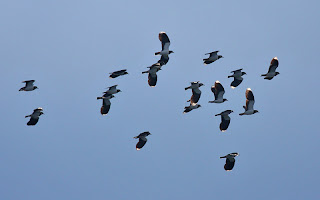
En route back to the car from the hides a Buzzard provided great views as it circled and called above the field I was walking past. It didn't seem to mind my presence and flew towards me a number of times, affording me the luxury of photographing a raptor head on rather than the usual rear view as they retreat to a 'safe' distance.
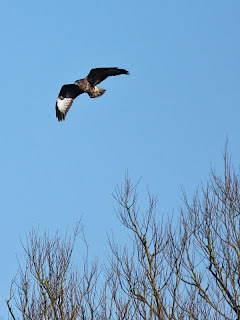

Final stop for today was pit 41, site of a few drake Smew sightings recently. Alas, a couple of scans revealed no Smew but I did pick up three Red-crested Pochard (1m/2f) for the year list and get good views of a small flock of Siskin feeding in trees along the shore.

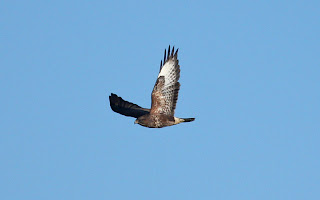
Plenty of pits still to investigate, and plenty of Winter still to go. Many of the larger areas of water are still partially frozen.
Year list stands at 67 this evening. There are some differences in content (still no Wren or Pied Wagtail this year!), but I'm running pretty much parallel with last year in terms of numbers.
Of course, every pit had varying numbers of Gadwall, Tufted Duck, Pochard and all but pit 12 contained Wigeon. Without any given purpose, I won't count Gulls (scan through them, of course)... so let's just say there were lots of each pretty much everywhere except GBBGs, or which I saw very few.

Pit 12 brought me my first Common Gull of the year (photo above of the first one I clapped eyes on) alongside my first Little Grebe, Great Crested Grebes and Goldeneye (3m/1f) of the year. There were perhaps 20 Mute Swans present, frequently taking flight and - every time - amusing as they attempted touchdown on the ice. Plenty of Black-headed Gulls but no candidates for Med.
Pit 17. A Great Spotted Woodpecker (seem to be running into these all over the place recently) made a racket along the shore. There were five Goosander (3m/2f) loitering along the far side.
On pit 16 there were four more Goldeneye (3m/1f). Around the edge I spotted a Treecreeper and a Goldcrest (although I only saw one there were more) - a welcome tick.
Pit 74. More Goldeneye (4m/6f), c.15 Cormorants often in flight. A Buzzard flew over the area and stirred great numbers of Wigeon into flight along with some Lapwing. A smaller flock of something took flight, too, but the view was simply too distant to identify them. I made my way around to the hides, but they didn't help. One Black-headed Gull's pursuit of a young Herring Gull (which had caught a small fish) was probably the highlight. Like a dogfight.

En route back to the car from the hides a Buzzard provided great views as it circled and called above the field I was walking past. It didn't seem to mind my presence and flew towards me a number of times, affording me the luxury of photographing a raptor head on rather than the usual rear view as they retreat to a 'safe' distance.


Final stop for today was pit 41, site of a few drake Smew sightings recently. Alas, a couple of scans revealed no Smew but I did pick up three Red-crested Pochard (1m/2f) for the year list and get good views of a small flock of Siskin feeding in trees along the shore.


Plenty of pits still to investigate, and plenty of Winter still to go. Many of the larger areas of water are still partially frozen.
Year list stands at 67 this evening. There are some differences in content (still no Wren or Pied Wagtail this year!), but I'm running pretty much parallel with last year in terms of numbers.
05 January 2011
BUBO Lists.
I've done some thinking, head scratching, and list checking, and now have 8 lists on there! All BOU. I'm quite confident they're all in good shape.
- Britain Life: 226
- Britain 2010: 213
- Gloucestershire Life: 169
- WWT Slimbridge Life: 126
- Isles of Scilly Life: 115
- Witcombe Reservoirs Life: 64
- Britain 2011: 57
- Garden List Life: 39
- Britain Life: 226
- Britain 2010: 213
- Gloucestershire Life: 169
- WWT Slimbridge Life: 126
- Isles of Scilly Life: 115
- Witcombe Reservoirs Life: 64
- Britain 2011: 57
- Garden List Life: 39
03 January 2011
Lesser Scaup-fest.
One Slimbridge collection bird (left), one wild bird (right):
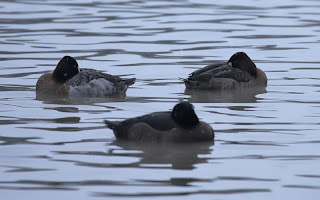
The collection bird is older, and so is greyer. It also (even in my lousy photograph) clearly possesses a brighter yellow iris. In comparison the wild bird has a dull iris - indicative of a first winter bird.
Although plumage and head shape were always available for inspection, I was fearful that the bird would keep its most prized distinguishing feature tucked away for the duration of my visit. However, I'm pleased to report that it did raise its head and have a stretch. It was snowing onsite so the photographs are as good as I could comfortably manage. The first image shows the white wing bar trailing into grey through the primaries.
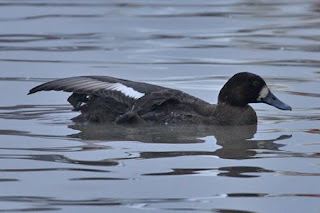
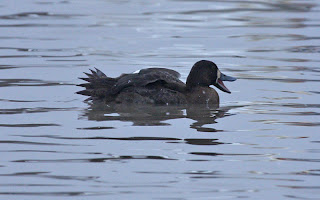
As I was leaving, I photographed it swimming about:
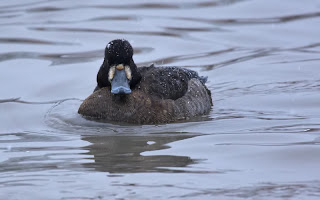
I also decided that the male Mandarin Duck on the Pen was fair game for a tick. The Slimbridge wardens seem content that it's wild.
In the morning I popped into Coombe Hill Meadows and added a few bits and bobs to my year list (which I'm not interested in!). The most pleasing (of nothing spectacular) were Treecreeper and Great Spotted Woodpecker. 55 now.
Also onsite - from the Grundon Hide - were over 100 Greylags, a few Canada Geese, a distant flock of Wigeon (couple of hundred birds perhaps), two Lapwing, three Buzzards and a fly through Sparrowhawk.
I was pleased to see that there is now a longer raised walkway allowing access to the Grundon Hide from the canal towpath. This should mean that when the fields next flood, the hide will still be accessible.

The collection bird is older, and so is greyer. It also (even in my lousy photograph) clearly possesses a brighter yellow iris. In comparison the wild bird has a dull iris - indicative of a first winter bird.
Although plumage and head shape were always available for inspection, I was fearful that the bird would keep its most prized distinguishing feature tucked away for the duration of my visit. However, I'm pleased to report that it did raise its head and have a stretch. It was snowing onsite so the photographs are as good as I could comfortably manage. The first image shows the white wing bar trailing into grey through the primaries.


As I was leaving, I photographed it swimming about:

I also decided that the male Mandarin Duck on the Pen was fair game for a tick. The Slimbridge wardens seem content that it's wild.
In the morning I popped into Coombe Hill Meadows and added a few bits and bobs to my year list (which I'm not interested in!). The most pleasing (of nothing spectacular) were Treecreeper and Great Spotted Woodpecker. 55 now.
Also onsite - from the Grundon Hide - were over 100 Greylags, a few Canada Geese, a distant flock of Wigeon (couple of hundred birds perhaps), two Lapwing, three Buzzards and a fly through Sparrowhawk.
I was pleased to see that there is now a longer raised walkway allowing access to the Grundon Hide from the canal towpath. This should mean that when the fields next flood, the hide will still be accessible.
02 January 2011
35.
These are the birds I aim to see for the first time (in the wild) in 2011. Although other stuff will inevitably crop up, these will be the priority:
Bean Goose
Ruddy Shelduck
Eider
Velvet Scoter
Slavonian Grebe
Red-necked Grebe
White-tailed Eagle
Hen Harrier
Honey Buzzard
Rough-legged Buzzard
Stone Curlew
Dotterel
Jack Snipe
Arctic Skua
Caspian Gull
Glaucous Gull
Roseate Tern
Long-eared Owl
Tawny Owl
Hoopoe
Lesser Spotted Woodpecker
Wryneck
Woodlark
Shore Lark
Water Pipit
Nightingale
Ring Ouzel
Grasshopper Warbler
Crested Tit
Bearded Tit
Penduline Tit
Chough
Common/Mealy Redpoll
Snow Bunting
Cirl Bunting
Bean Goose
Ruddy Shelduck
Eider
Velvet Scoter
Slavonian Grebe
Red-necked Grebe
White-tailed Eagle
Hen Harrier
Honey Buzzard
Rough-legged Buzzard
Stone Curlew
Dotterel
Jack Snipe
Arctic Skua
Caspian Gull
Glaucous Gull
Roseate Tern
Long-eared Owl
Tawny Owl
Hoopoe
Lesser Spotted Woodpecker
Wryneck
Woodlark
Shore Lark
Water Pipit
Nightingale
Ring Ouzel
Grasshopper Warbler
Crested Tit
Bearded Tit
Penduline Tit
Chough
Common/Mealy Redpoll
Snow Bunting
Cirl Bunting
1st January.
I'd hoped to spot the Lesser Scaup on the Rushy at Slimbridge, but couldn't find it. As it turns out, neither could many better birders than me. I did get a much better look at that other Greater Scaup (the one I thought was a female).
Definitely a male. Blaze not big enough for a female, I was told... and now I've seen it in clear conditions (no fog!) it has the beginnings of pretty strong grey vermiculation on it's back. Also, one could - on occasion - catch a hint of green on it's head. Indeed, I think this photo shows the green - at least it does on my screen.
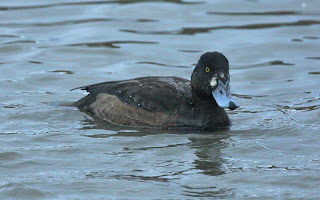
I picked up 43 species for my 2011 year list - including a great Redhead Smew from the Zeiss Hide. Here is a typically spectacular photograph of it:
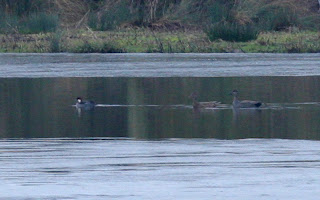
Still, this year isn't going to be about frantically adding to a year list, rather (in the majority) about finding and seeing a list of 35 birds I've never seen before. I'll post the list very soon.
Definitely a male. Blaze not big enough for a female, I was told... and now I've seen it in clear conditions (no fog!) it has the beginnings of pretty strong grey vermiculation on it's back. Also, one could - on occasion - catch a hint of green on it's head. Indeed, I think this photo shows the green - at least it does on my screen.

I picked up 43 species for my 2011 year list - including a great Redhead Smew from the Zeiss Hide. Here is a typically spectacular photograph of it:

Still, this year isn't going to be about frantically adding to a year list, rather (in the majority) about finding and seeing a list of 35 birds I've never seen before. I'll post the list very soon.
01 January 2011
Sex Change.
Subscribe to:
Posts (Atom)





